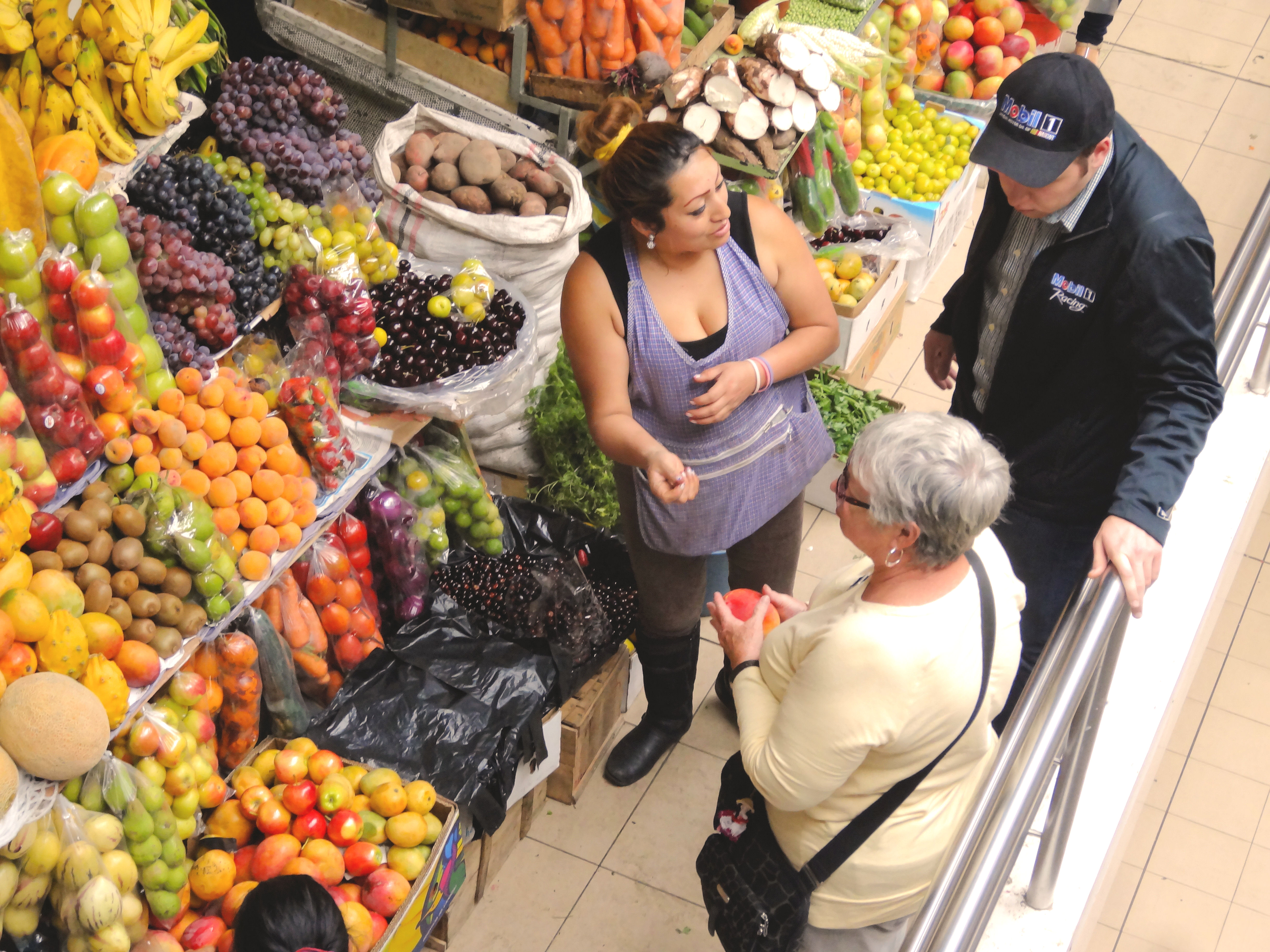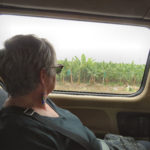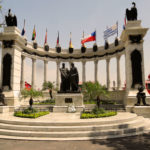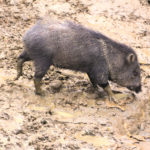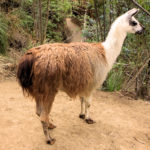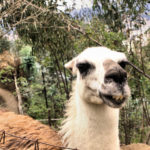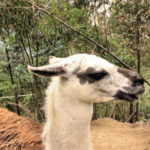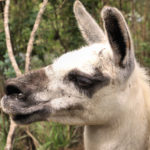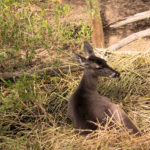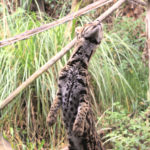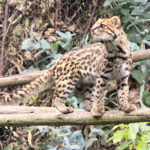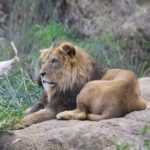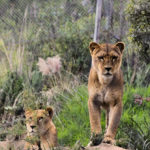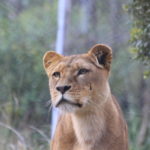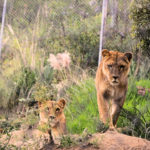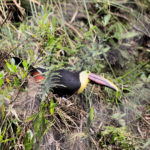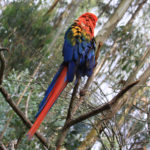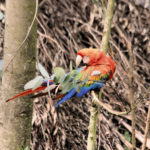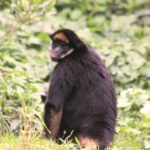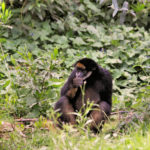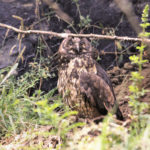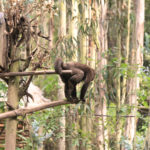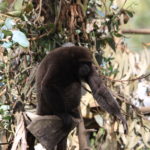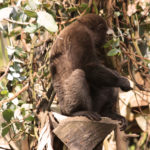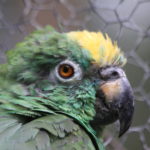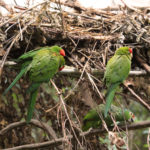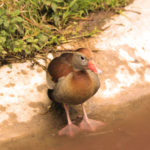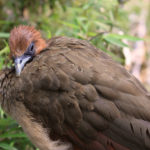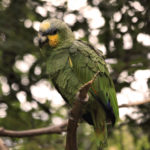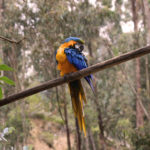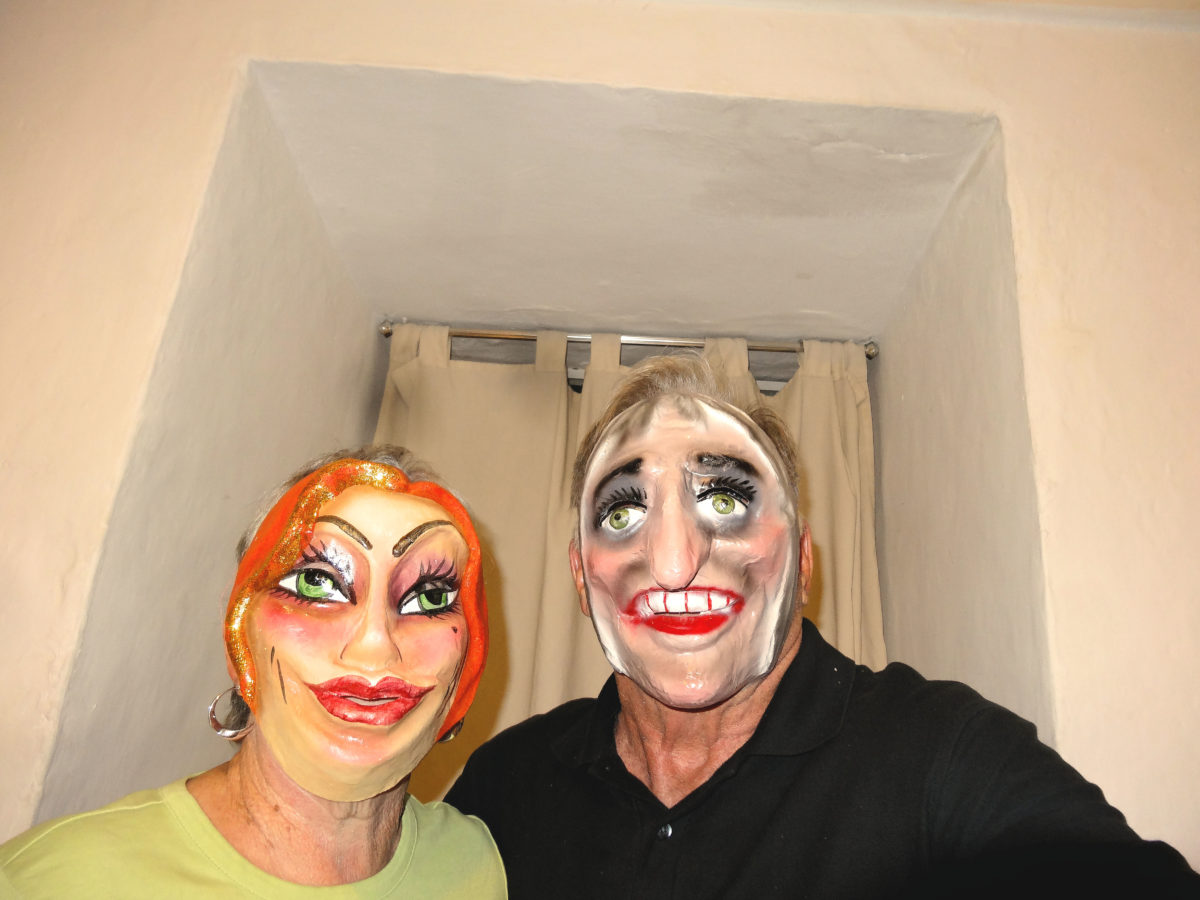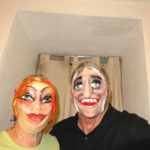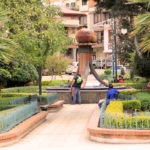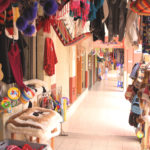Today we picked our grandson Thomas Knight up from the airport. He is going to visit us until we all return to the US. He is pretty exhausted from not sleeping since yesterday so we made a short loop around the main plaza, had lunch and visited the market. He had his first experience at haggling. He did ok on the fruit and really good with the hog head. He got it for $5.
Category: Ecuador
And so Back to Cuenca
Guayaquil was a nice change. Luxurious sheets, well appointed room, Sangria brought from the bar and something besides Animal Planet on TV. We met a nice couple bicycling around the world who were staying in the hotel while she recovered from an accident and another couple at breakfast who were astounded that we had traveled on a bus. So the level of adventure does vary from traveler to traveler. We hired a driver to bring us back to Cuenca and I am not so sure we were any better off than on the bus, but the ride was beautiful if a bit scary. Leaving Guayaquil we were struck by the stark poverty that we saw in contrast to the natural beauty of the landscape. Dirty little towns and shacks sat along the road with open air restaurants were full of local resi ents eating lunch and drinking coffee. Their houses are little shacks on stilts each with one opening for a door and no windows. Some have new tin on the roof, but most the them have a rusty roof that would do little to protect the homeowner. A few scrawny chickens peck in the muddy dirt hunting for insects or worms. The people have no garden space to supplement their obviously poor diet. However, their native artistic sense is evident in their fruit stands. Mangoes, bananas, papaya, and watermelon are beautifully arranged on carts in a manner that best shows off the color and shape of the fruit. They are selling cut melons that were artful. We are always impressed by their merchandizing ability. They do not seem unhappy with their lives. They swim in the river have picnics by the water and play like children. Maybe the simple life suits them or they simply do not know any other way to live. The huge agribusiness fields are well tended and stretch as far as the eye can see while the smaller plots are worked by hand. I am sure many of the folks work for the agribusinesses when it is time to pick the crops. Small trucks loaded with bananas head west to Guayaquil to be sold to markets. We leave the flat lands and head up the mountain.
This is where the trip gets scary. The road is slick and curvy and we are soon in the clouds. The driver does not slow down. Troy tries to sleep so he can ignore this Mr. Toad’s Wild Ride. He does not sleep and I do not try. I think Manuelo believes that PILEGRO ZONA DERRUMBLES means drive like hell and no passing really meant TAKE OFF WHAT DO YOU HAVE TO LOSE. Honk the horn and everybody must get out of the way. WE stop for lunch which was chicken soup with a wing and a boiled egg in it which we bolt down and hit the road again. The scenery is gorgeous. Huge philodendron, ferns, lichen grow out of the mountain which constantly nourishes them with water and minerals. Lack of sun light means there are no flowers except for an occasional lupine. There is no sign of human activity until many miles later and then we sight small hotels, fishing camps and some ranching activity. This area is much more prosperous. There are garden plots, roses and Shasta daisies growing in the yard, children wear school uniforms and play alongside the road. Much of this area is CAJA NATIONAL PARK and the residents benefit from the park visitors. Soon Cuenca appears. This beautiful little jewel of a city nestles in the valley of four rivers. The Old Cathedral and the New Cathedral wait patiently for us. The maid did not come to the apartment as we wished but it doesn’t really matter.
Adios,
Sally
Guayaquil Hot and Humid
 Guayaquil is a tropical city and very different from Quito and Cuenca. We spent the morning in some very typical Texas weather. We visited Las Penas on the north end of the Malecon which represents the old Guayaquil. That area has been destroyed by fire, flood and faced an epidemic that killed thousands of its citizens. Las Penas is now an artist colony, boutique shopping area and a Bohemian settlement with some of the old wooden houses. They are built into the side of a hill almost on top of each other. They are pastel,and shuttered with interesting open design panesl to let in air. Some of the most famous Ecuadorian citizens had homes there. A fort protected Las Penas from invaders. I loved the interesting houses and the attempt to use them today.
Guayaquil is a tropical city and very different from Quito and Cuenca. We spent the morning in some very typical Texas weather. We visited Las Penas on the north end of the Malecon which represents the old Guayaquil. That area has been destroyed by fire, flood and faced an epidemic that killed thousands of its citizens. Las Penas is now an artist colony, boutique shopping area and a Bohemian settlement with some of the old wooden houses. They are built into the side of a hill almost on top of each other. They are pastel,and shuttered with interesting open design panesl to let in air. Some of the most famous Ecuadorian citizens had homes there. A fort protected Las Penas from invaders. I loved the interesting houses and the attempt to use them today.
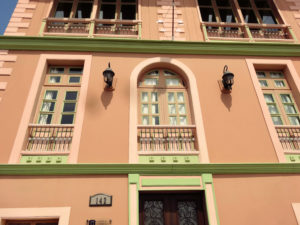

A giant Ferris Wheel slow turns along the Malecon giving the visitor a chance to see the old city and the new city and the busy river at the same time. Further down the Malecon there are beautiful gardens, a children’s playground a wide assortment of restaurants. The most beautiful statuary is of Simon Boliver and Jose de San Martin who worked to gain independence for countries in South America. We finished our sightseeing at the Museo Central which houses a number of pre Columbian artifacts and portraits of more Ecuadorian presidents that you would ever hope to see. Interestingly the museum is free, but they checked out passports and dutifully recorded the number in a dusty old notebook. Why we don’t know. In an attempt to cut down on crime there are volunteers about the city who wear a vest with the oxymoron “authorized vigilante” on the back. They watch parked cars, small parks and other public areas to make them safer.
On the Road to Quayaquil
Monday Morning, January 2 found us at the Terminal Terrestre hunting a bus to Guayaquil. We purchased our ticket just inside the terminal, saving ourselves .20 and having to fight through the turnstile. We also got assigned seats so if the bus filled up we would not get kicked off. For $17 we had a seat that would let us enjoy some of the most beautiful scenery in Ecuador. The route takes us through the upper part of Parque Cajas one of the many national parks in Ecuador. Along the road are beautiful trout streams and fields of the fattest dairy cattle ever. The bus climbs to the top of the mountain and llamas graze peacefully as they have done for centuries. Pristine volcanic lakes glimmer in the sunlight and every shade of green imaginable dots the mountainside relieved by huge boulders. WE see few people. Occasionally a farm house or two dot the country side. The route begins to descend the mountains and the landscape changes from rocks, lakes and trees to scattered banana plants. Locals stand beside the road trying to sell their fresh bananas. Suddenly as far as we can see there are banana plants with the full stalks of bananas wrapped in green plastic wrap to protect them from birds and other damage. On the opposite side of the road there are papaya plantations. The road is littered with dirty little towns that provide places for the plantation workers to live. Here it is evident that we are visiting a third world country. The towns consist of shacks that hardly seem livable, a number of cafes which are all full of people eating lunch and a sad little church or school. Children and adults swim in the swift moving river alongside the towns. Nothing much changes until we reach Duran, a small town on the outskirts of Guayaquil. Vendors appear with water bottles, rags to clean windshields and in some cases they break dance or juggle for a few pennies. I admire their optimism. About half the passengers leave the bus at Duran and the rest continue the journey. In about 30 minutes we reach Guayaquil bus station which is a mad house. We grasp our belongings and finally make our way through the terminal and find a taxi. A price is negotiated and we are soon at the Palace Hotel. Guayaquil is very different from Quito and Cuenca. It is not a colonial city and the buildings are modern and unimaginative. When we check in the handsome young clerk proudly points to the Iguana Park and tells us to watch out for iguana poop when we go. It is good advice. The hotel is lovely, a nice change for us and Troy is already looking for plane tickets to return to Cuenca on Thursday. The thought of that bus station is almost too much.
Zoologico Amaru – 2 (Photographs)
 This is a follow-up to the Zoologico Amaru post Sally did earlier. It contains a series of photographs I did for the Director of Economics at the Zoo for the zoo to use for publicity and fundraising. This is not your typical zoo. The Zoologico Amaru is one of the most interesting zoos we have ever visited. About 15 minutes out of town the zoo is literally carved from the side of a mountain consequently there is a lot of climbing, breaks for spectacular vistas, and surprises around every bend of the path. The animals are housed in natural habitats and can be observed in an environment that is most comfortable for them. The sign clearly states that the primary purpose of the zoo is to provide sanctuary and peace for the animals. To get a good photograph of some of the animals is extremely difficult. The photographs attached are for you to enjoy. Feel free to copy if you would like.
This is a follow-up to the Zoologico Amaru post Sally did earlier. It contains a series of photographs I did for the Director of Economics at the Zoo for the zoo to use for publicity and fundraising. This is not your typical zoo. The Zoologico Amaru is one of the most interesting zoos we have ever visited. About 15 minutes out of town the zoo is literally carved from the side of a mountain consequently there is a lot of climbing, breaks for spectacular vistas, and surprises around every bend of the path. The animals are housed in natural habitats and can be observed in an environment that is most comfortable for them. The sign clearly states that the primary purpose of the zoo is to provide sanctuary and peace for the animals. To get a good photograph of some of the animals is extremely difficult. The photographs attached are for you to enjoy. Feel free to copy if you would like.
Troy Knight
The New Year
 Dummies or Majotes decorate shop fronts, taxis, and private cars all over Cuenca. Most of them represent political figures and you can add your thoughts to their message board, some are cartoon characters, and some are more sophisticated displays created by an entire neighborhood. In the end they will be kicked to the curb and set on fire, symbolizing the end of the old year and what ever grief or despair that was there is now burned and a fresh slate awaits the New Year.
Dummies or Majotes decorate shop fronts, taxis, and private cars all over Cuenca. Most of them represent political figures and you can add your thoughts to their message board, some are cartoon characters, and some are more sophisticated displays created by an entire neighborhood. In the end they will be kicked to the curb and set on fire, symbolizing the end of the old year and what ever grief or despair that was there is now burned and a fresh slate awaits the New Year.


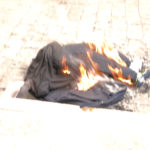

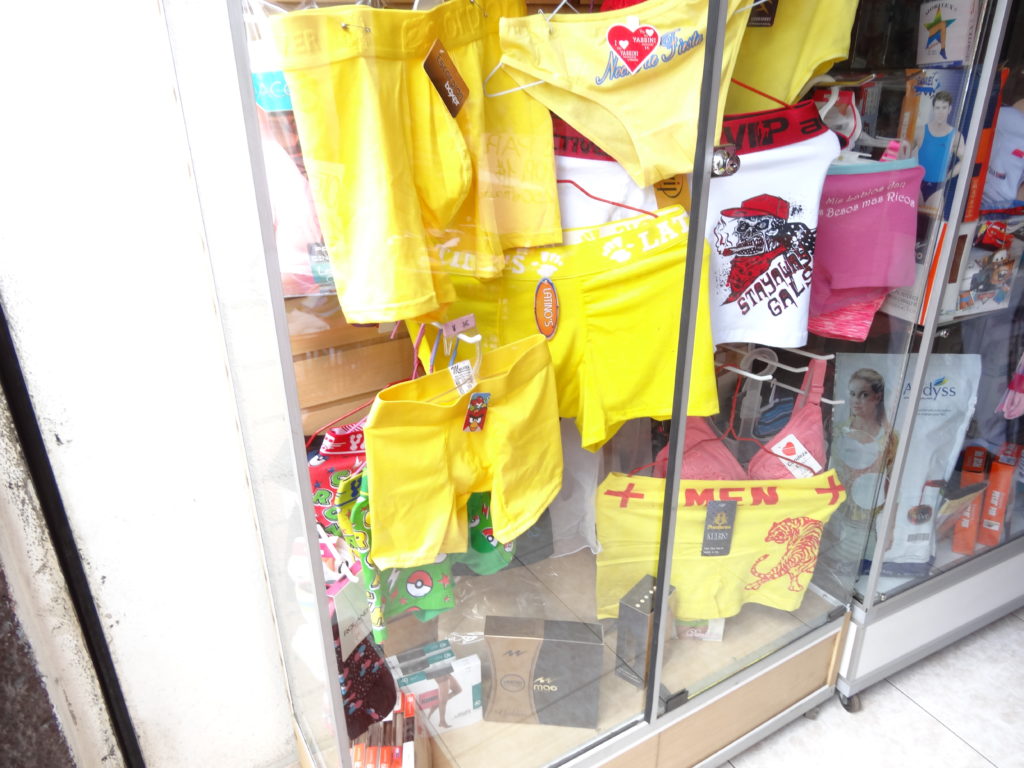 Yellow underwear for all genders and ages is worn for good luck, twelve grapes are consumed at midnight, young men dressed like Viajes or widows roam the neighborhood begging candy and pennies, and free beer stands are set up in the neighborhood. Who could ask for more.
Yellow underwear for all genders and ages is worn for good luck, twelve grapes are consumed at midnight, young men dressed like Viajes or widows roam the neighborhood begging candy and pennies, and free beer stands are set up in the neighborhood. Who could ask for more.
http://www.life-in-ecuador.com/ecuador-new-years.html
Feliz Ano Nuevo as they say in Cuenca.
Sally
Zoologico Amaru
 The Zoologico Amaru is one of the most interesting zoos we have ever visited. About 15 minutes out of town the zoo is literally carved from the side of a mountain consequently there is a lot of climbing, breaks for spectacular vistas, and surprises around every bend of the path. The animals are housed in natural habitats and can be observed in an environment that is most comfortable for them. The sign clearly states that the primary purpose of the zoo is to provide sanctuary and peace for the animals. Lewis and Clark University and the University of Philadelphia are active partners with the sanctuary and we met two young men who were employed by AMARU and who had visited the Houston Zoo and Moody Gardens. The very secretive Andean bear was one of the first animals we visited. The habitat was huge and included ponds, feeding stations and a bear cave. Though we were able to see the bears Troy could not get a good photo. The bears and all the other animals in the zoo are rescue animals and could not be returned to the wild.
The Zoologico Amaru is one of the most interesting zoos we have ever visited. About 15 minutes out of town the zoo is literally carved from the side of a mountain consequently there is a lot of climbing, breaks for spectacular vistas, and surprises around every bend of the path. The animals are housed in natural habitats and can be observed in an environment that is most comfortable for them. The sign clearly states that the primary purpose of the zoo is to provide sanctuary and peace for the animals. Lewis and Clark University and the University of Philadelphia are active partners with the sanctuary and we met two young men who were employed by AMARU and who had visited the Houston Zoo and Moody Gardens. The very secretive Andean bear was one of the first animals we visited. The habitat was huge and included ponds, feeding stations and a bear cave. Though we were able to see the bears Troy could not get a good photo. The bears and all the other animals in the zoo are rescue animals and could not be returned to the wild.
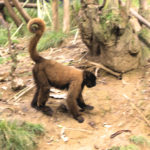 What is a zoo without monkeys? These little fellows seem to have the run of the entire space. Tunnels made of chicken wire are all around the park at the top of the trees and at first glance they seem to be moving about without being hindered. They drop onto islands scattered about the area, disappear into underground tunnels, pop back up and continue the monkey life. They are not bored because they are stimulated constantly as they would be in the wild.
What is a zoo without monkeys? These little fellows seem to have the run of the entire space. Tunnels made of chicken wire are all around the park at the top of the trees and at first glance they seem to be moving about without being hindered. They drop onto islands scattered about the area, disappear into underground tunnels, pop back up and continue the monkey life. They are not bored because they are stimulated constantly as they would be in the wild.
 The birds were very representative of Ecuador. Beautiful macaws, green parrots, and the big beaked tucan are free to fly about the large aviary. There was also an area for owls, several condors, eagles of different kinds and ducks, geese and the Pavo Reales or as we know it a peacock. We even saw the blue footed boobie.
The birds were very representative of Ecuador. Beautiful macaws, green parrots, and the big beaked tucan are free to fly about the large aviary. There was also an area for owls, several condors, eagles of different kinds and ducks, geese and the Pavo Reales or as we know it a peacock. We even saw the blue footed boobie.
 These beautiful tigres knew it was time to be fed and they set up a growl as two young men approached their habitat with food. There were some African animals. A nice pride of lions dominated another area of the zoo. The path we followed was over 5 kilometers. There was no attempt to make the walk easy, however for safety there was a hand rail. We moved up and down and in and out of areas and it was not an easy walk. We were among the last of the guests to leave and the young man checking our tickets said his boss called and asked if Troy would send him the pictures he took. We feel honored he asked. Not a traditional zoo, but better and no better place to spend my birthday.
These beautiful tigres knew it was time to be fed and they set up a growl as two young men approached their habitat with food. There were some African animals. A nice pride of lions dominated another area of the zoo. The path we followed was over 5 kilometers. There was no attempt to make the walk easy, however for safety there was a hand rail. We moved up and down and in and out of areas and it was not an easy walk. We were among the last of the guests to leave and the young man checking our tickets said his boss called and asked if Troy would send him the pictures he took. We feel honored he asked. Not a traditional zoo, but better and no better place to spend my birthday.
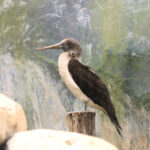


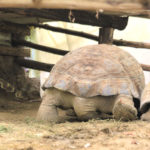
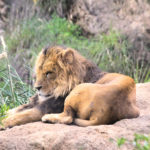
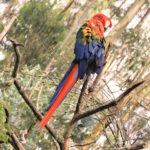
New Year’s Eve Preparation
Almost as soon as Christmas is over Cuenca begins to prepare for the New Year. Vendors take down Christmas cards and lights. Inventory unsold Santa hats and Nativity sets and bring out the New Years items. Here it is not so much about greeting the New Year as it is saying good-bye to the old. Masks of political figures, the famous and infamous are sold for two dollars and everyone buys them. Dummies stuffed with newspapers, fireworks, vegetable and animal matter are built and erected around neighborhoods. These will be set on fire to get rid of the bad and make room for the good to come. Taxis and family cars are decorated with them. Young men in drag call themselves the widows and go about demanding candy, money and beer. Fireworks are set off all over the city. This along with the bonfires makes quite a spectacle. Some of the gringos living here tried to put a stop to the random fireworks and Cuencans said no dice. Love it or leave it. We got into the spirit early today and bought our masks. Note the two characters below. Apparently around 4 to 6 AM it comes to a halt and the city sleeps all day. No shops or restaurants open so we will need to be supplied for the day.
Prospero Ano
Sally
Gualaceo to Chordeleg
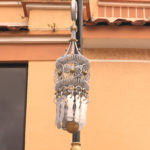 Today Troy and I took a bus trip to two small towns outside of Cuenca. The bus station was relatively easy to manipulate. Put in a dime enter the turnstile and find a bus that has the name of the town on your agenda. The bus was clean and comfortable and no animals were permitted so the stereotype of traveling with chickens did not exist. However, while sitting on the bus waiting to leave a young woman gets on delivers a sales pitch about who knows what passes out lovely pieces of candy and then proceeds to continue her pitch. She then moves up the aisle collecting money. If you did not pay, she takes the candy back. There were a few crying children. She exits and another gentleman proceeds to give out Milagros, then he gives a chain to put the milagro on, same routine he tries to collect money if you don’t donate away goes the milagro. No babies cried. Next the Herbal Life man makes a pitch. He hands out a pack of vitamins. No dinero; no vitamins. By this time we arrive in Gualaceo.
Today Troy and I took a bus trip to two small towns outside of Cuenca. The bus station was relatively easy to manipulate. Put in a dime enter the turnstile and find a bus that has the name of the town on your agenda. The bus was clean and comfortable and no animals were permitted so the stereotype of traveling with chickens did not exist. However, while sitting on the bus waiting to leave a young woman gets on delivers a sales pitch about who knows what passes out lovely pieces of candy and then proceeds to continue her pitch. She then moves up the aisle collecting money. If you did not pay, she takes the candy back. There were a few crying children. She exits and another gentleman proceeds to give out Milagros, then he gives a chain to put the milagro on, same routine he tries to collect money if you don’t donate away goes the milagro. No babies cried. Next the Herbal Life man makes a pitch. He hands out a pack of vitamins. No dinero; no vitamins. By this time we arrive in Gualaceo.

The little church was beautiful inside and the town obviously does not have many visitors because the tourist office only had one map.
 Lunch was in a family restaurant. This young man is thirteen and anxious to help his family be successful. Lunch was fried fish and the beer was cold. Hernan directed us to the bus station and we headed for Chordeleg.
Lunch was in a family restaurant. This young man is thirteen and anxious to help his family be successful. Lunch was fried fish and the beer was cold. Hernan directed us to the bus station and we headed for Chordeleg.
s
Piedras de Aguas
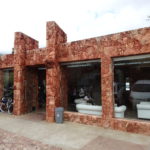 The little town of Banos which is about 10 miles South of Cuenca is known for its thermal waters and spas. Piedras de Aguas is one of the better ones and if you make inquiries you can do a spa circuit for $35 for two. The spa is a series of caves cut into the mountain and three beautiful pools and several restaurants. The first step in a shower and 15 minutes in a steam room followed by the mud baths.Next we entered the red mud bath which is full of iron and works as an exfolient. Covering as much of the body as possible, the red mud dyes the nails, hair and Troy left with a red beard. Sit in the sun until it dries and wash it off and shower and go for the green mud .
The little town of Banos which is about 10 miles South of Cuenca is known for its thermal waters and spas. Piedras de Aguas is one of the better ones and if you make inquiries you can do a spa circuit for $35 for two. The spa is a series of caves cut into the mountain and three beautiful pools and several restaurants. The first step in a shower and 15 minutes in a steam room followed by the mud baths.Next we entered the red mud bath which is full of iron and works as an exfolient. Covering as much of the body as possible, the red mud dyes the nails, hair and Troy left with a red beard. Sit in the sun until it dries and wash it off and shower and go for the green mud .

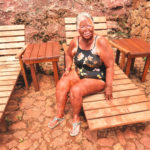
The green mud supposedly contains gold, silver and quartz. Another shower and it is time for the thermal baths. The thermal baths consist of a warm pool for 10 minutes and a freezing pool for a minute. No one ever lasts a full minute in the cold pool. This is followed by an  old fashioned steam bath.
old fashioned steam bath.
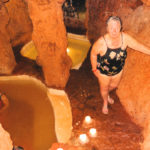
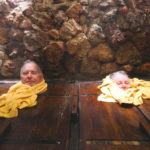
We treated ourselves to a chocolate massage and lunch in the restaurant. Look for bargains and these experiences need not be expensive.

